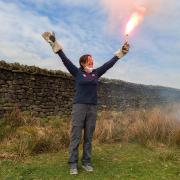Gamekeepers aren’t shy when it comes to embracing new technology, says land management expert Brian Sweeney

The idea of drones flying over our heather moors may make some shiver with dread but the technology, most often associated with military action, is making a difference to the management of the countryside. Drones are now part of the curriculum for students studying gamekeeping at Askham Bryan College, near York. And the technology is a welcome, time saving piece of kit, says course lecturer Brian Sweeney.
‘Modern agriculture is embracing new technology all the time,’ he said. ‘We felt our gamekeepers would benefit from investigating which new technologies could enhance their course and ultimately their careers.
‘Gamekeepers aren’t shy about using new ideas, new technologies or new science. We have embraced GPS tracking for personal use and for our working dogs, all-terrain vehicles have been adopted readily and we’re now using state of the art drugs to treat some bird diseases prophylactically.
‘The drone seemed an obvious choice for gamekeeping. It gives land managers an affordable eye in the sky and an aerial view of the world we would otherwise not be able to have. It allows us to map our environment and using the mapping data, manage that environment better. Good contemporary data allows accurate assessment of the landscape and therefore more informed decisions about management.

‘In upland gamekeeping, grouse keepers can use images from a drone to examine their moors and from the information gathered make precise plans for heather burning, bracken removal and the maintenance of shoot infrastructure (butts, bridges, paths etc). In agriculture, drones can be used to assess cereal fields, measure growth rate and even monitor livestock.’
And like most technologies, a drone saves time. Using conventional methods of walking the landscape takes an exceptionally long time. ‘The drone is easy to fly,’ says Brian. ‘And it’s easy to access the data it supplies. Most staff can be quickly trained to use the drone. Some landowners may have reservations regarding the legality and the liability of flying a drone on their land. There are questions of privacy to neighbours, hazard to other aerial craft (planes, helicopters etc) and some sporting estate owners may feel the drone flying over their estate or moor may frighten their birds (in reality there are many more scary avian predators to worry about). Ultimately the benefits outweigh any niggles; it provides affordable up to date data to inform our decision making.
‘From a teaching perspective, the drone allows us to help students engage with the landscape and landscape management. Collecting your own landscape photographs and analysing your own landscape data is much more exciting than using old aerial photographs which are often out of date.
‘Gamekeeping is, in a modern context, a mix of old tradition and new technologies. It evolves as any industry evolves; new ideas and new technologies are reviewed, trialled and adopted if found worthy. Young gamekeepers are as technology aware as any group of their peers; they have the latest phones, gadgets and computers. Drone technology is well within their grasp and understanding.

‘I think drones will ultimately become a familiar piece of kit in every keeper’s 4x4, next to the gun and the dog as a standard tool of the job. How and where the drone will be deployed is dependent on the imagination of the user. I am sure we’ll see unique and surprising uses beyond mere landscape mapping, perhaps searching for lost dogs or delivering forgotten lunches to someone on a distant hill!’



























